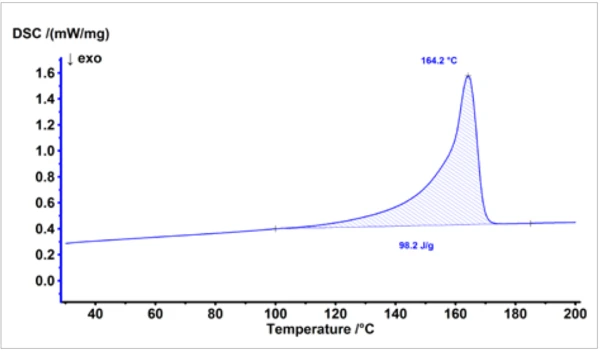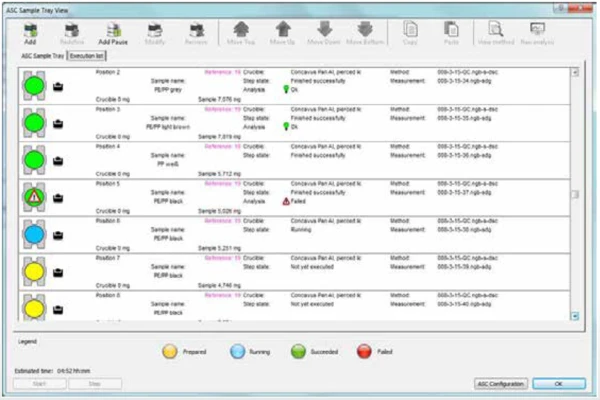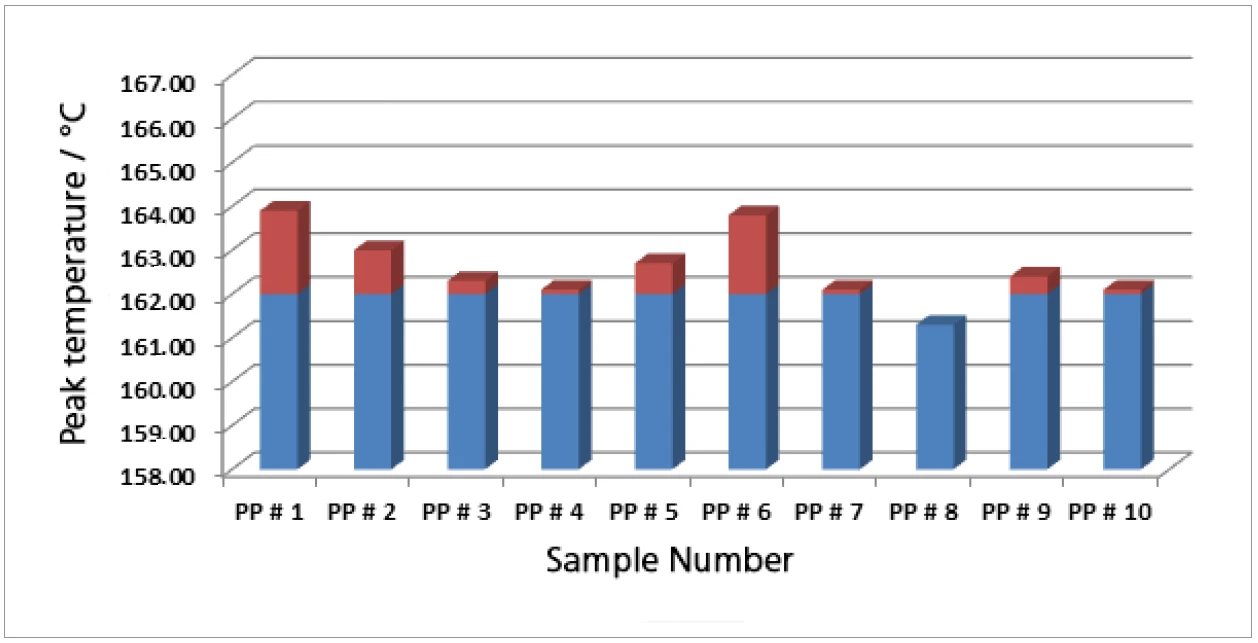Introduction
For routine applications in incoming goods inspection or quality assurance, the focus is more on the determination of characteristic values than on material identification. Thus, known materials are always evaluated with the same routines in order to compare them with reference materials and evaluate quality standards. This allows for material batches which do not meet requirements to be identified and sorted out in time.
With the introduction of Identify, the thermoanalytical NETZSCH Proteus® database, unknown samples can be recognized and identified quickly and reliably [1]. Of course, this database can also assess known samples in terms of how similar their thermal behavior is to that of retained samples or reference substances. This similarity comparison takes a variety of effects into consideration – mostly automatically evaluated – and also assesses the sample to be investigated with regard to whether all effects typical for this material were really detected. This approach is particularly advantageous for the identification of mixtures and mixture ratios [2].
Another possibility for evaluating samples is offered by the NETZSCH Proteus® evaluation software with the creation of new measurement methods. This application note will describe how measurement methods – along with the quality criteria mentioned – are programmed, and how they can be used for evaluation purposes.
Programming of a Measurement Method
Measurement methods serve as a template for routine tasks in which identical measurement conditions and an identical measurement program are to be used for a variety of samples requiring investigation. For the programming of measurement methods, there are several possibilities.
A) As with an individual measurement, all measurement parameters are programmed in the measurement software, but as methods rather than as measurement files. These methods can be reused again at any time as a template for this kind of measurement. Further, one can open and alter the method and save it again under a different name.
B) The measurement method is not created in the measurement program, but in the evaluation program of the NETZSCH Proteus® software. A pre-existing measurement serves here as a template for the method. The individual processing steps which were carried out with the pre-existing measurement in the evaluation software – such as the selection of individual segments, smoothing of the measurement data, selection of the depicted measurement range, evaluation of results such as peak area, or determination of the Temperatura de Transición VítreaThe glass transition is one of the most important properties of amorphous and semi-crystalline materials, e.g., inorganic glasses, amorphous metals, polymers, pharmaceuticals and food ingredients, etc., and describes the temperature region where the mechanical properties of the materials change from hard and brittle to more soft, deformable or rubbery.glass transition temperature – are thus adopted into the method. If another sample measurement is carried out based on this method, all evaluation steps are automatically implemented after the measurement is finished.
C) As described under B), a method is created using a preexisting measurement including the evaluation steps. Additionally, quality criteria are determined which also evaluate the sample results obtained after measurement and evaluation. This way, it can be ensured that all measurements can be carried out with the identical measurement program and under identical measurement conditions, that identical evaluation steps are applied to all measurement data, that all measurement results are based on the identical evaluation ranges (positions of the cursors) and that the evaluations of the results are based on identical criteria and are therefore ideally suited for comparison.
Results and Discussion
The melting behavior of a variety of polypropylene samples was analyzed by means of the NETZSCH DSC 214 Polyma for evaluation purposes. A comparison sample was thus selected to serve as a benchmark for all subsequent samples. The granulate lens of this comparison sample was cut in half longitudinally and was transferred with the smooth cut surface into a NETZSCH Concavus® aluminum crucible.
The sample, with a weight of 5.319 mg, was heated twice to 200°C at heating and cooling rates of 10 K/min. The melting behavior of the second heating segment is shown in figure 1. The evaluated melting enthalpy of 98.2 J/g and the peak temperature of 164.2°C represent the reference values on the basis of which the quality criteria for the following investigations were determined.

Figure 2 shows how a measurement method can be created using the NETZSCH Proteus® evaluation software, whereby the method creation is based on the current evaluation state. Additionally, quality criteria can be defined for the evaluated results. As an example, we set these at ± 2 K for the peak temperature and ± 5% for the melting enthalpy. Figure 3 shows the necessary entries in the software.


By means of the measurement method so created, 10 other polypropylene samples were investigated with the NETZSCH DSC 214 Polyma equipped with ASC sample tray. Already during the measurement, one gets an indication as to whether the samples investigated fulfill the defined quality criteria or not. The symbol in the history log of the automatic sample changer (figure 4) indicates that the criteria are fulfilled; the symbol, in contrast, marks samples which do not fulfill the defined requirements for at least one criterion.

The presentation of the results – evaluated automatically after each measurement – does not include any special notification for cases in which all quality criteria are fulfilled. If, however, an evaluated value is outside of the defined ranges, an exclamation mark will follow the presented result. The measurement result shown in figure 5 thus fulfills the criterion of the peak temperature, but not that of the melting enthalpy.

A summary of the results for all polypropylene samples is shown for the melting enthalpy in figure 6 and for the peak temperature in figure 7.


The point of the color transition from blue to red depicts the lower boundary for each of the quality criteria; the upper boundary was not exceeded in any of the measurement examples. It can quickly be seen that polypropylene samples PP#5, PP#6 and PP#10 do not fulfill the quality criteria due to melting enthalpies that are too low. This might be caused, for example, by differing amounts of inert fillers which may, in turn, result in changes in mechanical properties. The peak temperatures, on the other hand, were detected as being within the quality criteria limits for all samples except sample PP#8, which exhibits too low a value. The reasons for this may lie in additives and impurities such as other polyolefins.
Summary
The NETZSCH Proteus® evaluation software offers a variety of possibilities with regard to automated sample analysis and automated evaluation of measurement results.
With the introduction of Identify, the first thermoanalytical database, it is now possible for the first time to comprehensively evaluate measurement results with regard to the temperature and intensity of detected signals, and also with regard to the possible lack of signals that would otherwise be characteristic for the corresponding material.
The possibilities for automatic evaluation of the results discussed in this work, in contrast, are based on individual measurement values such as peak temperature or melting enthalpy. These cases illustrate this approach only as examples, of course. It is also entirely possible to substantiate other measurement values, like the glass transition temperature of amorphous substances or the extrapolated onset of a beginning reaction, in a similar way using quality criteria. These can, of course, also be transferred to other materials such as metals, pharmaceuticals or food. Since the quality criteria can be freely selected, the materials to be investigated can be very selectively evaluated – for example, using very restrictive criteria. This work thus showed that the NETZSCH Proteus® software allows not only for automated sample measurement and evaluation, but also for very individualized, sample-specific adjustments to the automatic assessment of results.